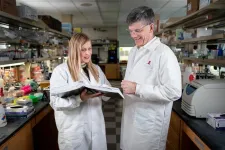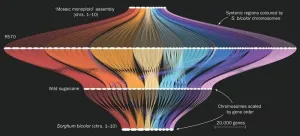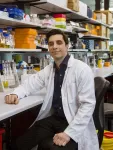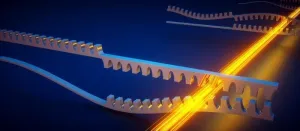(Press-News.org) St. Jude Children’s Research Hospital scientists reversed an aggressive cancer, reverting malignant cells towards a more normal state. Rhabdoid tumors are an aggressive cancer which is missing a key tumor suppressor protein. Findings showed that with the missing tumor suppressor, deleting or degrading the quality control protein DCAF5 reversed the cancer cell state. These results suggest a new approach to curing cancer — returning cancerous cells to an earlier, more normal state rather than killing cancer cells with toxic therapies — may be possible. The results were published today in Nature.
“Rather than making a toxic event that kills rhabdoid cancer, we were able to reverse the cancer state by returning the cells toward normal,” said senior author Charles W.M. Roberts, MD, PhD, Executive Vice President and St. Jude Comprehensive Cancer Center director. “This approach would be ideal, especially if this paradigm could also be applied to other cancers.”
“We found a dependency which actually reverses the cancer state,” said first author Sandi Radko-Juettner, PhD, a former St. Jude Graduate School of Biomedical Sciences student, now a Research Program Manager for the Hematological Malignancies Program at St. Jude. “Standard cancer therapies work by causing toxicities that also damage healthy cells in the body. Here, it appears that we’re instead fixing the problem caused by the loss of a tumor suppressor in this rhabdoid cancer.”
Drugging the un-targetable
In many cancers, there is no easily druggable target. Often, these cancers are caused by a missing tumor suppressor protein, so there is nothing to target directly as the protein is missing. Loss of tumor suppressors is much more common than a protein gaining the ability to drive cancer. Consequently, finding a way to intervene therapeutically in these tumors is a high priority. The researchers were looking for a way to treat an aggressive set of cancers caused by the loss of the tumor suppressor protein SMARCB1 when they found a new approach to treatment.
The St. Jude group found a little-studied protein, DCAF5, was essential to rhabdoid tumors missing SMARCB1. Initially, they identified DCAF5 as a target, using the Dependency Map (DepMap) portal, a database of cancer cell lines and the genes critical for their growth. DCAF5 was a top dependency in rhabdoid tumors. After the initial finding, the scientists genetically deleted or chemically degraded DCAF5. The cancer cells reverted to a non-cancerous state, persisting even in a long-term mouse model.
“We saw a spectacular response,” Roberts said. “The tumors melted away.”
Removing quality control to reverse cancer
Normally, SMARCB1 is an essential component of a larger chromatin-regulating complex of proteins called the SWI/SNF complex. Unexpectedly, the study found that in the absence of SMARCB1, DCAF5 recognizes SWI/SNF as abnormal and destroys the complex. When DCAF5 degrades them, the researchers showed that SWI/SNF re-forms and maintains its ability to open chromatin and regulate gene expression. While the SWI/SNF activity level in the absence of SMARCB1 was to a lesser extent than usual, it was nonetheless sufficient to reverse the cancer state fully.
“DCAF5 is doing a quality control check to ensure that these chromatin machines are built well,” Roberts said. “Think of a factory assembling a machine. You need quality checks to examine and find faults and to pull it off the line if it doesn’t meet standards. DCAF5 is doing such quality assessments for the assembly of SWI/SNF complexes, telling the cell to get rid of complexes if SMARCB1 is absent.”
“The mutation of SMARCB1 shuts off gene programs that prevent cancer. By targeting DCAF5, we’re turning those gene programs back on,” Radko-Juettner said. “We’re reversing the cancer state because the cell is becoming more ‘normal’ when these complexes aren’t targeted for destruction by DCAF5.”
Future therapeutic opportunities to reverse cancer
“From a therapeutic perspective, our results are fascinating,” Radko-Juettner said. “DCAF5 is part of a larger family of DCAF proteins that have been shown to be drug targetable. We showed that when DCAF5 is absent, mice had no discernable health effects, so we could potentially target DCAF5. This can kill the cancer cells but shouldn’t affect healthy cells. Targeting DCAF5 thus has the potential to avoid the off-target toxicity of radiation or chemotherapy, making it a promising therapeutic avenue to pursue.”
Beyond DCAF5, the findings could have implications for other cancers driven by the loss of a tumor suppressor.
“We have demonstrated a beautiful proof of principle,” Roberts said. “Myriad types of cancers are caused by tumor suppressor loss. We hope we may have opened the door to thinking about new ways to approach targeting at least some of these by reversing, instead of killing, cancer.”
Authors and funding
The study’s other first author is Hong Yue of the Dana-Farber Cancer Institute and Harvard Medical School. The study’s other co-corresponding author is Eric Fischer, Dana-Farber Cancer Institute and Harvard Medical School. The study’s other authors are Katherine Donovan, Moritz Hunkeler, Shourya Burman and Anna Schmoker, Dana-Farber Cancer Institute and Harvard Medical School; Nada Mageed, Harvard Medical School; Behnam Nabet, Fred Hutchinson Cancer Center; Nathanael Gray, Stanford Cancer Institute; Jacquelyn Myers, Raymond Carter, Alexis Robertson, Priya Mittal, Zhexin Zhu, Baranda Hansen, Wojciech Rosikiewicz, Zhiping Wu, Meghan McReynolds, Scott Brown, Robert Mobley, Janet Partridge, Elizabeth Stewart, Shondra Pruett-Miller and Junmin Peng, St. Jude.
The study was supported by grants from the National Cancer Institute (NCI) (R01 CA113794, R01 CA273455 and R01 CA172152, K22 CA258805, R01 CA262188 and CCSG 2 P30 CA021765), the Garrett B. Smith Foundation, the St. Jude Children’s Research Hospital Collaborative Research Consortium on Chromatin Regulation in Pediatric Cancer, St. Jude Graduate School of Biomedical Sciences, Ruth L. Kirschstein National Research Service Award (F31 CA261150), National Institute on Aging (RF1AG068581) and ALSAC, the fundraising and awareness organization of St. Jude.
St. Jude Media Relations Contact
Rae Lyn Hartley
Cell: (901) 686-2597
raelyn.hartley@stjude.org
media@stjude.org
St. Jude Children's Research Hospital
St. Jude Children's Research Hospital is leading the way the world understands, treats and cures childhood cancer, sickle cell disease and other life-threatening disorders. It is the only National Cancer Institute-designated Comprehensive Cancer Center devoted solely to children. Treatments developed at St. Jude have helped push the overall childhood cancer survival rate from 20% to 80% since the hospital opened more than 60 years ago. St. Jude shares the breakthroughs it makes to help doctors and researchers at local hospitals and cancer centers around the world improve the quality of treatment and care for even more children. To learn more, visit stjude.org, read St. Jude Progress, a digital magazine, and follow St. Jude on social media at @stjuderesearch.
END
Researchers turn back the clock on cancer cells to offer new treatment paradigm
Scientists at St. Jude Children’s Research Hospital discovered that removing a second protein from cancer cells already experiencing tumor suppressor loss can reverse cancer cell identity
2024-03-27
ELSE PRESS RELEASES FROM THIS DATE:
SwRI leads airborne, ground-based 2024 eclipse observation projects
2024-03-27
SAN ANTONIO — March 27, 2024 —Southwest Research Institute is leading two groundbreaking experiments — on the ground and in the air — to collect astronomical data from the total solar eclipse that will shadow a large swath of the United States on April 8, 2024. SwRI’s Dr. Amir Caspi leads the Citizen Continental-America Telescopic Eclipse (CATE) 2024 experiment, a broad scientific outreach initiative funded by the National Science Foundation (NSF) and NASA, that will ...
Lighting up the future
2024-03-27
New multidisciplinary research from the University of St Andrews could lead to more efficient televisions, computer screens and lighting.
Researchers at the Organic Semiconductor Centre in the School of Physics and Astronomy, and the School of Chemistry have proposed a new approach to designing efficient light-emitting materials in a paper published this week in Nature (27 March).
Light-emitting materials are used in organic light-emitting diodes (OLEDs) that are now found in the majority of mobile ...
Sweet success: researchers crack sugarcane’s complex genetic code
2024-03-27
Modern hybrid sugarcane is one of the most harvested crops on the planet, used to make products including sugar, molasses, bioethanol, and bio-based materials. It also has one of the most complex genetic blueprints.
Until now, sugarcane’s complicated genetics made it the last major crop without a complete and highly accurate genome. Scientists have developed and combined multiple techniques to successfully map out sugarcane’s genetic code. With that map, they were able to verify the specific location that provides resistance to the impactful brown rust disease ...
WISPR team images turbulence within solar transients for the first time
2024-03-27
WASHINGTON — The Wide-field Imager for Parker Solar Probe (WISPR) Science Team, led by the U.S. Naval Research Laboratory (NRL), captured the development of turbulence as a Coronal Mass Ejection (CME) interacted with the ambient solar wind in the circumsolar space. This discovery is reported in the Astrophysical Journal.
Taking advantage of its unique location inside the Sun’s atmosphere, the NRL-built WISPR telescope on NASA’s Parker Solar Probe (PSP) mission, operated by the Johns Hopkins University Applied Physics Laboratory (JHUAPL), captured in unparalleled detail the interaction between ...
Undocumented immigrants faced unique mental health challenges during COVID-19 pandemic
2024-03-27
Four years after the U.S. shut down in the face of the COVID-19 pandemic, research from Rice University suggests undocumented immigrants’ mental health challenges were compounded due to stresses stemming from their unauthorized status.
“Implications of Undocumented Status for Latinx Families During the COVID-19 Pandemic: A Call to Action” appears in the Journal of Clinical Child & Adolescent Psychology and examines how undocumented immigrants navigated the COVID-19 pandemic.
During a series of in-depth interviews with undocumented individuals or those from ...
Old immune systems revitalized in Stanford Medicine mouse study, improving vaccine response
2024-03-27
Planes, trains, boats, automobiles and even feet. During the past decades and centuries, global travel and human migration have made all of us more worldly — from our broadening awareness of the world beyond our birthplaces, to our more sophisticated palates, to our immune systems that are increasingly challenged by unfamiliar bacteria and viruses.
In the elderly, these newly imported pathogens can gain the upper hand frighteningly quickly. Unfortunately, however, vaccination in this age group isn’t as effective as it is in younger people.
Now a study conducted in mice by Stanford ...
Discovery has potential to solve the billion-dollar global cost of poorly managed wound healing
2024-03-27
Scientists have uncovered a key step in the wound healing process that becomes disabled in diseases like diabetes and ageing, contributing to a global healthcare cost of managing poorly healing wounds exceeding $250 billion a year. Importantly, the research published in Nature reveals a molecule involved in the healing of tissues that – when injected into animal models – leads to a drastic acceleration of wound closure, up to 2.5 times faster, and 1.6 times more muscle regeneration.
Lead researcher, Associate Professor Mikaël Martino, from Monash University’s Australian Regenerative Medicine Institute (ARMI) in Melbourne, Australia, said the discovery ...
Newly uncovered history of a key ocean current carries a warning on climate
2024-03-27
It carries more than 100 times as much water as all the world's rivers combined. It reaches from the ocean's surface to its bottom, and measures as much as 2,000 kilometers across. It connects the Indian, Atlantic and Pacific oceans, and plays a key role in regulating global climate. Continuously swirling around the southernmost continent, the Antarctic Circumpolar Current is by far the world's most powerful and consequential mover of water. In recent decades it has been speeding up, but scientists have been unsure whether ...
Evolution of the most powerful ocean current on Earth
2024-03-27
The Antarctic Circumpolar Current plays an important part in global overturning circulation, the exchange of heat and CO2 between the ocean and atmosphere, and the stability of Antarctica’s ice sheets. An international research team led by the Alfred Wegener Institute and the Lamont-Doherty Earth Observatory have now used sediments taken from the South Pacific to reconstruct the flow speed in the last 5.3 million years. Their data show that during glacial periods, the current slowed; during interglacials, it accelerated. Consequently, if ...
New topological metamaterial amplifies sound waves exponentially
2024-03-27
Researchers at AMOLF, in collaboration with partners from Germany, Switzerland, and Austria, have realized a new type of metamaterial through which sound waves flow in an unprecedented fashion. It provides a novel form of amplification of mechanical vibrations, which has the potential to improve sensor technology and information processing devices. This metamaterial is the first instance of a so-called ‘bosonic Kitaev chain’, which gets its special properties from its nature as a topological material. It was realized by making nanomechanical resonators interact with laser light through radiation pressure forces. The discovery, which is published on March ...
LAST 30 PRESS RELEASES:
Clearing the brain of aging cells could aid epilepsy and reduce seizures
Brain injuries linked with potential risk of suicide, new study finds
New technique lights up where drugs go in the body, cell by cell
New study finds movement of fishing fleets can reveal shifts in marine ecosystems
Embargoed: New evidence points to potential treatment for vascular dementia
Study uncovers disrupted brain balance in alcohol dependence
Working in groups can help Republicans and Democrats agree on controversial content moderation online
Structural findings reveal how distinct GPCR ligands create different levels of activation
Anything-goes “anyons” may be at the root of surprising quantum experiments
UC review: Maximizing workplace opportunity for veterans
From generation to complex control: Metasurfaces make perfect vortex beams "within reach"
Thin-film lithium niobate-based detector: recent advances and perspectives
Exploring why some people may tend to persistently make bad choices
How cells balance their protein levels
Nirsevimab vs RSVpreF vaccine for RSV–related hospitalization in newborns
Effectiveness and impact of maternal RSV immunization and nirsevimab on medically attended RSV in US children
AI gives scientists a boost, but at the cost of too many mediocre papers
Next-generation vision model maps tree growth at sub-meter precision
Genes aren’t destiny for inherited blindness, study shows
MIT study: High-fat diets make liver cells more likely to become cancerous
Exposure to multiple fine particulate matter components and incident depression in the US Medicare population
Risk of burdensome health care spending over time in the US
Nirsevimab against hospitalizations and emergency department visits for lower respiratory tract infection in infants
New microfluidics technology enables highly uniform DNA condensate formation
A new strategy for immune tolerance
Super Mario Bros. help fight burnout: New study links classic games to boosted happiness
Deepest gas hydrate cold seep ever discovered in the arctic: International research team unveils Freya Hydrate Mounds at 3,640 m depth.
Integrating light and structure: Smarter mapping for fragile wetland ecosystems
ACA-SIM: A robust way to decode satellite signals over complex waters
Probiotics can restore gut microbiome in breastfed infants
[Press-News.org] Researchers turn back the clock on cancer cells to offer new treatment paradigmScientists at St. Jude Children’s Research Hospital discovered that removing a second protein from cancer cells already experiencing tumor suppressor loss can reverse cancer cell identity










